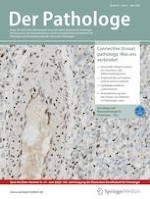Erschienen in:

06.04.2022 | Hepatozelluläres Karzinom | Schwerpunkt: Connective (tissue) pathology: Was uns verbindet!
Epitheliale kindliche Lebertumoren
Eine Übersicht der neuen WHO-Klassifikation für pädiatrische Tumoren
verfasst von:
J. F. Lau, Prof. Dr. C. Vokuhl
Erschienen in:
Die Pathologie
|
Ausgabe 3/2022
Einloggen, um Zugang zu erhalten
Zusammenfassung
Kindliche Lebertumoren sind sehr seltene Tumoren, welche unter 1 % aller kindlichen Malignome ausmachen. Die häufigsten Tumoren im Bereich der Leber stellen Hepatoblastome dar. Im Rahmen dieser Übersicht sollen die epithelialen malignen kindlichen Lebertumoren besprochen werden, wobei insbesondere auf die Morphologie der verschiedenen Hepatoblastomsubtypen eingegangen wird. Zudem werden die anderen malignen Lebertumoren wie der sog. hepatozelluläre Tumor, NOS, sowie der zweithäufigste kindliche Lebertumor, das hepatozelluläre Karzinom, besprochen. Neben den typischen morphologischen Charakteristika werden auch die immunhistochemischen und molekularen Aspekte behandelt, welche helfen können, diese sich teils deutlich ähnelnden Entitäten zu unterscheiden.











